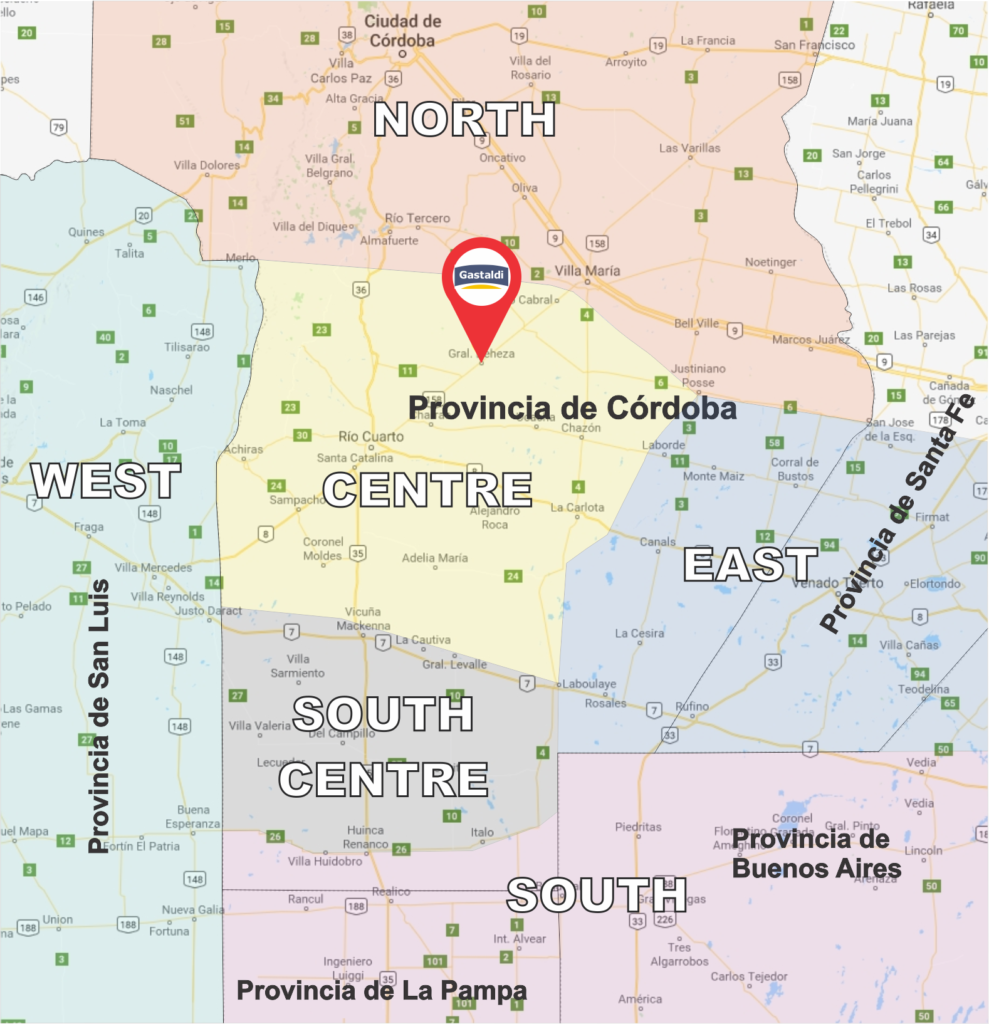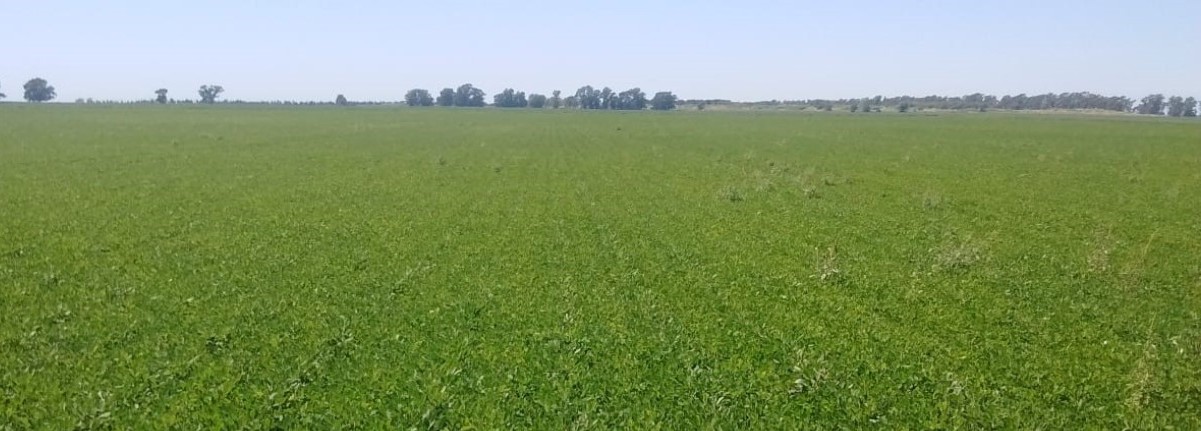Argentine Peanut Crop Report
Season 2019/2020 – #4
General Overview
The general state of the Argentine peanut crop is good for most of the planted area. However, the lack of rainfall over the last month has generated concern among all actors in the Argentine peanut sector. The crop is going through a temporary drought stage just at the time of greatest water demand, in which vegetative growth should be maximized, thus consolidating yield potentials. Following the widespread lack of rainfall, coupled with the high temperatures of recent weeks, some fields mainly located in the Western area began to show losses in productive potential and delays in vegetative development.

Peanuts in a field located between the southwest of the Cordoba province and the east of the San Luis province – Western area
Zooming in, the situation in the different areas of our reference map is somewhat heterogeneous. The most compromised area continues to be the west, formed by the west of the province of Cordoba and the east of San Luis. There, some losses are estimated that, at this point, would already be irreversible. The rest of the areas however are in better condition. The Central and Northern areas are in good condition, since they were planted late, so the yield expectations are still optimistic. The Eastern and South-Central areas also have a positive outlook, mainly due to the large pool of water accumulated in the soils throughout the season, which means that the crop can access water reserves despite not having received considerable rains recently. Finally, the Southern area presents intermediate and irregular conditions. Compared to the state of the peanut crop of the last report, the situation has deteriorated, although the temporary drought condition is reversible in most cases, as long as significant rainfall is recorded in the near future. The forecast for the next few days indicates probability of rains, which would be excellent news to reverse the reported condition.

Peanuts in La Cesira – Eastern area
The current condition of the crop, according to the survey by the team of agronomists of Gastaldi, is the following:

Crop condition as of 05-03-2020
The comparison between the present results and those from the previous report shows the deterioration in the general condition of the crop in the last month:
• Excellent: 10% (current) vs 20% (last month)
• Very good: 28% vs 35%
• Good: 20% vs. 22%
• Regular: 35% vs 20%
• Bad: 7% vs. 3%
Main Peanut Area Map
The main peanut area in Argentina includes the provinces of Cordoba, La Pampa, San Luis and Buenos Aires. In general terms, it can be divided as follows:

Main peanut area in Argentina
Rainfall and Temperature Analysis
Since the date of the last report, no new rains have been recorded throughout the peanut area. Although February presented records of significant rainfall, they occurred during the first week of February, so they had already been considered in the previous report. From that moment, the rains were scarce to zero for all the areas of our reference map, which contributed to deteriorating the general condition of the peanut crop.
The Western and Southern areas did not receive any rainfall, generating accumulated records that were well below the historical average for this time of year. Consequently, soil water reserves quickly ran out, generating a worrying condition in the peanut crop, since it is currently undergoing thermal and water stress conditions. It should be noted that rainfall in these areas during February is among the lowest recorded in 10 years.
Although rainfall was not recorded in the rest of the areas after the first week of February, the crop here is in better conditions, given that the water reserves in the soil are larger, which makes it possible to alleviate the scarcity of rains in the last weeks. On the other hand, some fields located mainly in the South-Central and Southern areas have been planted late, so water requirements are still not as high as in the rest of the fields in which the crop is in full vegetative development.
Although February ended with records of significant rainfall, the vast majority occurred during the first 10 days of the month, generating a marked shortage of rainfall from those days:


Accumulated rainfall in the province of Cordoba during February 2020 vs accumulated from February 1 to 10, 2020
As for the thermal records, an intense heat wave has occurred in the last month, with temperatures well above the historical records for this time of year. In many cities located in the peanuts area, temperatures were recorded consistently above 33 °C, which increased the effect of the lack of rainfall on the crop, adding a thermal stress condition to the already reported water stress.
Available Water Content in Cordoba
The maximum retention capacity or “field capacity” implies that the extraction of water by the vegetables occurs without any difficulty. Between the field capacity and the permanent wilting point there is the range of what we call useful water in the arable layer.
The figure shows that, for October in the peanut area, the average values are between 10% and 30% of useful water in the soil profile (drought condition).
The values improve towards the east side of Cordoba and northeast of the province of Buenos Aires.

Available Water Content in Argentina as of March 2nd, 2020 vs situation as of March 2nd, 2019
Extended forecasts for March, April and May predict normal rainfall in the province of Cordoba and lower than normal in the rest of the provinces where peanuts are planted. On the other hand, temperatures are forecasted above normal in the Argentine peanut zone.

Extended forecast of rainfall and temperatures in Argentina during March-April-May 2020
Phenological Development Stages
At the date of preparation of this report, 83% of the peanut is in an advanced reproductive state (R5), 11% is in a state of full seed (R6), and 6% is in an early reproductive state (R4).

General phenological state as of March 5th, 2020
The evolution of the phenological states in each zone of our reference map is as follows:

Evolution of the peanut crop phenological state by geographic area as of March 5th, 2020
Peanut Development Stages
V1: first tetrafoliolate leaf
V2: second tetrafoliolate leaf
V3: third tetrafoliolate leaf
V4: fourth tetrafoliolate leaf
V – (N): one to N developed nodes on main axis
R1: beginning bloom
R2: beginning peg
R3: beginning pod
R4: full pod
R5: beginning seed
R6: full seed
R7: beginning maturity
R8: harvest maturity
Crop-related Tasks
Weed treatments continue to control weeds in all areas of our reference map. In addition, hoe work is being carried out to control weeds that escape chemical treatments.
Because of the prevailing water stress, applications with insecticides for the control of spider mite were intensified. In many cases, growers had to carry out more than three applications due to the high incidence of this pest.
On the other hand, because of the current drought condition, the Sclerotinia Sp disease, which we have reported in the previous report, has stopped its progress.

Weed control with hoe in the Argentine peanut area
Final Remarks
Throughout the last month in Argentina, the condition of the new peanut crop has deteriorated as a result of the lack of rains in the last 4 weeks, as well as the heat wave with temperatures well above normal for this time of the year. Although the general condition can be classified as good, there is an urgent need to receive rains in the next few days, in order to reverse the reported water stress condition. The situation is especially worrisome in the western part of the peanut area, which has received the least amount of rainfall throughout the season, and already predicts irreversible losses, given that some peanut lots may not be dug. Other areas exhibit a better condition, aided by heavy rains during January and the first 10 days of February.
In order to consolidate the productive yields of the new peanut crop in Argentina, one last important and generalized rain is needed in the coming weeks. The forecast predicts conditions of instability that could derive into the needed rainfall. If this were the case, in general terms we could talk about a good peanut crop 2020 in Argentina, although results of the previous crop won’t be repeated for sure. On the other hand, if there is no significant rainfall in the coming weeks, the projected yields will need to be adjusted downwards and the quality of peanuts could be compromised.
Export taxes
To finalize this report, the national government of Argentina made an important announcement last week that directly impacts the peanut market. The Ministry of Agriculture announced the reduction of 5 percentage points in the export tax for Argentine peanuts. The news was very well received by the peanut sector that had been supporting a reduction in profit margins as a result of high tax pressure. However, this news is not expected to directly impact the price level of Argentine peanuts. Just as the price does not rise when tax increases are announced, they do not fall either when reductions are announced, as in this case. Peanuts are commercialized in an international market that is mainly driven by the bid between supply and demand. The situation of each country intervening individually does not usually play a role in determining the international price of peanuts.
Images

Peanuts in Lozada – Northern area


Peanuts in General Deheza – Central area


Peanuts in Del Campillo – South-Central area

Peanuts in La Cesira – Eastern area


Peanuts in a field located between the southwest of the Cordoba province and the east of the San Luis province – Western Area
Do you have a commercial inquiry?
Request for price quote
Other questions or comments?
Contact us: stembras@gastaldihnos.com.ar
Follow Gastaldi on social media:



